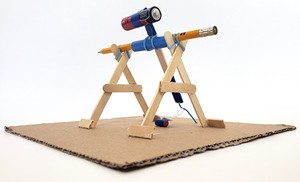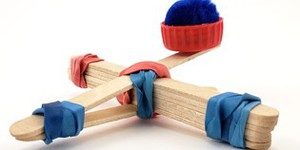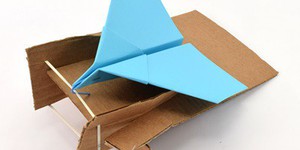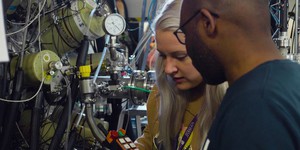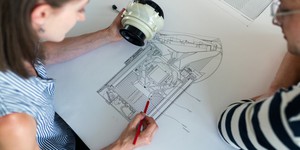Summary
20-30 minutes
20-30 minutes
Physics, engineering, potential energy, kinetic energy, conservation of energy
Ben Finio, PhD, Science Buddies
Introduction
You probably know what a catapult is. In the Middle Ages armies would use them to hurl stones at castle walls. But did you know about an even bigger type of medieval siege weapon called a trebuchet? Try this project to build a miniature version!
Materials
-
Piece of corrugated cardboard, about one foot by one foot
-
Popsicle sticks (8)
-
Scissors
-
Pencil
-
Jumbo or “milk shake” straw
-
Glue (a hot glue gun is best if available, but use caution and adult assistance when using hot glue.)
-
Tape
-
Rubber bands
-
String
-
Paper clip
-
AA battery
Prep Work
-
Assemble all your materials in a location that is open and clear of people, animals or breakable objects so that you can test your trebuchet. Safety note: Never aim projectiles at people or animals. A toy trebuchet might seem harmless, but even a small projectile can cause eye damage.
Instructions
-
Note: there is more than one way to build the trebuchet described in this project. For example, you could decide to build the entire frame out of pencils instead of popsicle sticks and you can choose whether you want to use tape, glue, or rubber bands to secure the different joints. Think of this as an engineering design project—there is no single “right answer” or correct way to build the trebuchet. You can modify your design based on your own ideas and the materials you have available.
-
Start out by building the two side A-frame pieces. Take five popsicle sticks and cut one of them in half. Glue the pieces together as shown in the picture, forming an “A” shape with a small notch at the top.
-
Carefully cut slots in your piece of corrugated cardboard that will allow your A-frame pieces to stand up straight, a few inches apart from each other. Stick the ends of the A-frame pieces into the slots. Reinforce the connections with glue/tape and some extra popsicle stick pieces if necessary so they remain standing on their own.
-
Now you will build the trebuchet’s arm. First, tape the AA battery to one end of a popsicle stick.
-
Unbend one end of a paper clip so it is almost, but not quite, straight. Attach the remaining flat part of the paper clip to the other end of the popsicle stick, with the straightened part pointing outward and up (away from the counterweight). This will serve as a hook to hold the “sling,” which in turn holds the projectile.
-
Cut a small section of milk shake straw, about one inch long. Attach this perpendicular to the popsicle stick arm using glue, rubber bands, or tape. The straw should be much closer to the counterweight than it is to the hook. (This distance is something you can try adjusting later.)
-
Slide the pencil into the milk shake straw.
-
Place the pencil into the two V notches on top of your A-frame pieces. Secure it in place with rubber bands. This forms a crossbar and completes your trebuchet’s frame. The straw and pencil form a pivot and should allow the arm to rotate. (We do not recommend using glue for this step—that way you can remove the crossbar and swap out the arm to make changes.)
-
Make sure your trebuchet is sturdy and the frame holds together. Try rotating the arm with your hand. If any of the joints seem weak or the frame wobbles significantly, reinforce them with tape, glue, or rubber bands.
-
Remove the eraser from the pencil and attach it to a small loop of string. Hang the eraser from the paper clip hook.
-
Now it is time to test your trebuchet. Use one hand to pull down on the eraser. This should raise the counterweight up in the air. Then, making sure no people, animals or breakable objects are nearby, let go.
What happens when you let the eraser go? Does it get launched forward? Does it go straight up in the air? Does it fail to release at all?
-
Now you might need to tinker with your trebuchet in order to get the best launch. Try pulling the eraser under the trebuchet frame. It is okay if the eraser is resting on the ground and there is slack in the sling. When the counterweight falls, it will drag the eraser along the ground and then pull it up into the air.
Can you find the best starting point for the eraser? What makes it go the farthest?
What Happened?
When you pull down on the eraser, this causes the battery to lift up in the air, giving it (gravitational) potential energy. When you release the eraser, the battery falls and its potential energy is converted to kinetic energy of the eraser. As the arm swings, the sling holding the eraser slides off the hook and the eraser’s kinetic energy causes it to fly through the air as a projectile.
Depending on exactly how you built your trebuchet, the results you see will vary. Remember that there is no single “correct” way to build the trebuchet. A well-built trebuchet should be able to hurl an eraser a few feet. Do not get discouraged if at first your trebuchet launches the eraser straight up in the air or fails to release it at all. You should be able to tinker with your design a bit (see recommendations at the end of the procedure) to get your eraser to launch.
Digging Deeper
The Science Buddies activity Build a Popsicle Stick Catapult shows you how to build a miniature catapult out of popsicle sticks and rubber bands. This catapult works by storing elastic potential energy—the type of energy you get from stretching something such as a rubber band or a spring—and rapidly converting it to kinetic energy (the energy of motion) of a projectile (in that case a cotton ball).
A trebuchet works differently. It relies on gravitational potential energy—the type of energy you get by raising something up off the ground. A trebuchet has a lever arm with a large, heavy counterweight on one end and a smaller projectile on the other end. When the counterweight is raised up, it has lots of gravitational potential energy. Then the counterweight is allowed to fall, rotating the lever arm and converting that potential into kinetic energy in the projectile, which is flung through the air. Many medieval trebuchets were larger and could hurl projectiles even farther than catapults.

Ask an Expert
Curious about the science? Post your question for our scientists.
For Further Exploration
- Try using lighter (or heavier) batteries. What impact do you think the weight of the counterweight will have on your projectile?
- Try changing the length of the lever arm. Both the overall length and the ratio between the distance from the pivot to the counterweight and the pivot to the sling. What happens if you move the pivot so it is exactly in the middle of the arm? What if you glue multiple popsicle sticks together to make a longer arm?
- What happens if you make the sling longer or shorter?
- What happens if you bend the paper clip so it is straighter or more curved or if it is cut to be shorter?
- What happens if you use something other than an eraser, such as a small balled up piece of paper?
Activities
STEM Activity
Catapults were mighty handy for pirates in the golden age of piracy (during the 17th century). And medieval knights used them centuries earlier for taking down massive castle walls. Even Greeks and Romans used catapults about 2,000 years ago! These simple machines are quite handy, as long as you know how to aim them! In this science activity you will try your hand at catapult technology. Can you predict where your cotton ball will land?
STEM Activity
Here’s a challenge: Try throwing a paper airplane by moving just your wrist (don’t move your elbow or shoulder). It’s hard, isn’t it? How could you get a paper airplane to fly far if you can use only a short distance to launch it? Try this activity to find out!
Careers
Career Profile
Mechanical engineers are part of your everyday life, designing the spoon you used to eat your breakfast, your breakfast’s packaging, the flip-top cap on your toothpaste tube, the zipper on your jacket, the car, bike, or bus you took to school, the chair you sat in, the door handle you grasped and the hinges it opened on, and the ballpoint pen you used to take your test. Virtually every object that you see around you has passed through the hands of a mechanical engineer. Consequently, their…
Career Profile
Physicists have a big goal in mind—to understand the nature of the entire universe and everything in it! To reach that goal, they observe and measure natural events seen on Earth and in the universe, and then develop theories, using mathematics, to explain why those phenomena occur. Physicists take on the challenge of explaining events that happen on the grandest scale imaginable to those that happen at the level of the smallest atomic particles. Their theories are then applied to…
Career Profile
Our universe is full of matter and energy, and how that matter and energy moves and interacts in space and time is the subject of physics. Physics teachers spend their days showing and explaining the marvels of physics, which underlies all the other science subjects, including biology, chemistry, Earth and space science. Their work serves to develop the next generation of scientists and engineers, including all healthcare professionals. They also help all students better understand their…
Career Profile
You use mechanical devices every day—to zip and snap your clothing, open doors, refrigerate and cook your food, get clean water, heat your home, play music, surf the Internet, travel around, and even to brush your teeth. Virtually every object that you see around has been mechanically engineered or designed at some point, requiring the skills of mechanical engineering technicians to create drawings of the product, or to build and test models of the product to find the best design.
Explore Our Science Videos
Build A Solar Updraft Tower!
Design and 3D Print a Snowflake
